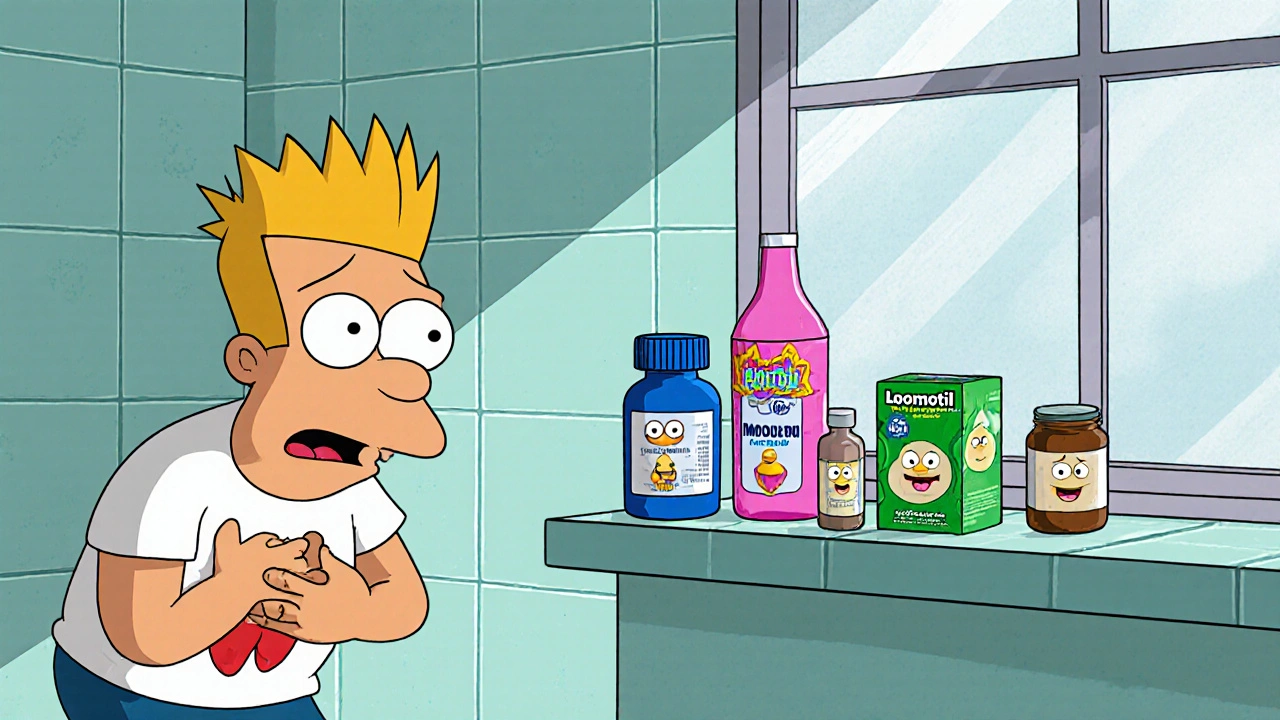Anti-Diarrheal Selection Guide
Choose the Right Anti-Diarrheal for Your Situation
Select your symptoms and conditions to get a personalized recommendation
Dealing with sudden diarrhea can be a nightmare-especially when you’re not sure which medicine will calm things down fastest without unwanted side effects. Below you’ll find a clear side‑by‑side look at Imodium and the most common alternatives, so you can pick the right one for your situation.
Quick Takeaways
- Imodium (loperamide) works by slowing gut movement; best for short‑term, non‑infectious diarrhea.
- Pepto‑Bismol (bismuth subsalicylate) adds antimicrobial action; good for travel‑related or stomach‑bug cases.
- Lomotil (diphenoxylate/atropine) is prescription‑only; reserved for severe or chronic diarrhea.
- Kaopectate (kaolin‑pectin) coats the stool; useful for mild upset and children.
- Probiotic supplements (e.g., Saccharomyces boulardii is a yeast probiotic that restores gut flora after antibiotics.) help prevent recurrence but act slower.
What Is Imodium (Loperamide)?
Imodium is the brand name for loperamide, an over‑the‑counter medication that reduces intestinal motility. By binding to opioid receptors in the gut wall, it slows the transit of stool, allowing more water to be reabsorbed. The result is firmer, less frequent bowel movements. Imodium comes in tablets, capsules, and liquid form, typically dosed at 2 mg for the first dose, followed by 2 mg after each loose stool, not exceeding 8 mg per day for adults.
Because loperamide acts locally in the gastrointestinal tract and does not cross the blood‑brain barrier in meaningful amounts, it has a low risk of central opioid effects when used as directed.
Common Over‑The‑Counter Alternatives
When Imodium isn’t the best fit-whether due to contraindications, specific infection types, or personal preference-several other agents are widely available.
Pepto‑Bismol (Bismuth Subsalicylate)
Bismuth Subsalicylate is the active ingredient in Pepto‑Bismol. It coats the stomach lining, reduces inflammation, and has mild antibacterial properties. It’s especially handy for travelers dealing with “traveler’s diarrhea” or for people who need an anti‑gas and anti‑nausea effect in the same pill.
Lomotil (Diphenoxylate/Atropine)
Diphenoxylate/Atropine (sold as Lomotil) combines an opioid‑like antidiarrheal with a low dose of atropine to discourage abuse. It’s prescription‑only in most countries and is reserved for chronic or severe cases where other OTC options have failed.
Kaopectate (Kaolin‑Pectin)
Kaolin‑Pectin is a clay‑based formulation that adsorbs toxins and then adds bulk to stool. It’s gentle on the stomach, making it a common choice for children over six months old.
Probiotic Supplements
Live bacteria or yeast, such as Saccharomyces boulardii, compete with harmful microbes and help restore a healthy gut microbiome. While they don’t stop diarrhea instantly, they reduce duration and prevent recurrence after a course of antibiotics.
Zinc Acetate
Zinc Acetate lozenges have been shown in pediatric studies to shorten diarrhea episodes by up to 50 %. It’s a simple, inexpensive adjunct, especially useful in low‑resource settings.
Oral Rehydration Solution (ORS)
While not an antidiarrheal, Oral Rehydration Solution is essential for preventing dehydration, the biggest danger of acute diarrhea. Commercial packets contain a precise balance of sodium, potassium, and glucose to promote water absorption.

Head‑to‑Head Comparison
| Feature | Imodium (Loperamide) | Pepto‑Bismol (Bismuth Subsalicylate) | Lomotil (Diphenoxylate/Atropine) | Kaopectate (Kaolin‑Pectin) | Probiotic (S. boulardii) |
|---|---|---|---|---|---|
| Mechanism | Slows intestinal motility | Coats stomach, mild antimicrobial | Opioid‑like slowdown + anticholinergic | Adsorbs toxins, adds bulk | Restores gut flora |
| OTC Availability | Yes | Yes | Prescription (in most regions) | Yes | Yes (as supplement) |
| Typical Use Cases | Acute, non‑infectious diarrhea | Traveler’s diarrhea, upset stomach | Chronic or severe diarrhea | Mild upset, children | Post‑antibiotic, prevention |
| Onset of Relief | 15-30 minutes | 30-60 minutes | 30-45 minutes | 45-60 minutes | 48-72 hours (preventive) |
| Common Side Effects | Constipation, abdominal cramping | Dark stool, constipation | Drowsiness, dry mouth | Constipation, possible allergic reaction | Gas, mild bloating |
| Contraindications | High fever, bacterial dysentery | Salicylate allergy, children <12 yr | Severe liver disease, pediatric use | Known clay allergy | Immunocompromised patients (rare) |
How to Choose the Right Remedy
Think of picking a diarrhea treatment like choosing a tool for a specific job. Here’s a quick decision flow you can run in your head:
- Is the cause bacterial? If you have high fever, blood in stool, or have just returned from a high‑risk area, avoid Imodium. Opt for Pepto‑Bismol or see a doctor.
- Do you need rapid relief? Imodium’s fast onset makes it the go‑to for sudden, non‑infectious episodes.
- Are you treating a child? Kaopectate is formulated for kids and avoids the opioid‑related risks of loperamide.
- Is this a chronic issue? Prescription Lomotil may be warranted after a professional assessment.
- Want to support gut health long‑term? Adding a probiotic like S. boulardii can reduce future flare‑ups.
Remember, the safest first step is always rehydration. Sip an ORS solution before reaching for any pill.

Safety and Side‑Effect Checklist
- Never exceed the maximum daily dose-8 mg for adults on Imodium.
- If you develop a fever >38.5 °C or blood in stool, stop the antidiarrheal and seek medical care.
- Watch for constipation; if stool becomes hard, pause the medication until regularity returns.
- People with liver disease should be cautious with loperamide and avoid diphenoxylate.
- Pregnant or nursing mothers should consult a healthcare provider before using any of these agents.
Practical Tips for Managing Diarrhea
Even the best medication can’t fix everything if you ignore basic care. Here are five habits that pair well with any of the treatments above:
- Hydrate smartly. Drink small sips of water, clear broth, or ORS every 15-20 minutes.
- Follow the BRAT diet. Bananas, rice, applesauce, and toast are gentle on the gut.
- Avoid irritants. Cut out caffeine, alcohol, dairy, and spicy foods until you’re back to normal.
- Rest your gut. Give your digestive system a break-no heavy meals for a few hours after taking medication.
- Track symptoms. Note when the diarrhea started, any accompanying fever, and how you responded to the medication. This info helps doctors if you need to see one.
Frequently Asked Questions
Can I use Imodium while I have a stomach virus?
If the virus is causing watery diarrhea without fever or blood, a short course of Imodium can ease symptoms. However, if you have a high fever, vomiting, or blood in stool, skip Imodium and focus on hydration; the virus needs to run its course.
What’s the difference between Imodium and Lomotil?
Both slow gut movement, but Imodium is OTC and works only in the intestines. Lomotil adds atropine to deter abuse and is usually prescribed for chronic or severe diarrhea. Lomotil also has a higher risk of drowsiness.
Is it safe to give Pepto‑Bismol to children?
Pepto‑Bismol is generally not recommended for kids under 12 because of the salicylate component. For younger children, Kaopectate or a pediatric‑formulated probiotic is a better choice.
How long should I keep taking Imodium?
Limit use to 48 hours or until you have two solid stools. If symptoms persist beyond that, stop the medication and consult a health professional.
Can probiotics replace antidiarrheal meds?
Probiotics support gut health but they act slower. They’re great for prevention or after‑effects, not for immediate relief. Pair them with an OTC antidiarrheal if you need quick symptom control.

Steven Young
Imodium is a classic example of Big Pharma pushing a quick fix while hiding the real risks. The drug slows your gut but also masks underlying infections that could become deadly if ignored. If you trust the label without questioning the hidden agenda you’re part of the problem.
Holly Green
Honestly the guide is solid – Imodium works for short‑term non‑infectious cases and Pepto‑Bismol is better for travel bugs. Just remember not to overuse any antidiarrheal.
Craig E
When the gut rebels, it reminds us of the ancient balance between fire and water within our bodies. Choosing an antidiarrheal is akin to selecting a mediator in a heated council; Imodium quiets the uproar, whereas probiotics nurture the peace after the storm. The key is to listen to the signals – fever, blood, or sheer dehydration are the trumpets of a deeper conflict. In that light, the table you compiled serves as a map for navigating these internal debates, offering both swift relief and long‑term harmony.
Marrisa Moccasin
Look, the pharmaceutical lobby, which controls the FDA, the CDC, even the research labs, has a vested interest in keeping us dependent on over‑the‑counter pills, and Imodium is just another cog in that machine, a convenient placebo that distracts us from the real cure-restoring natural gut flora, which they deliberately suppress with patented probiotics, all while they line their pockets with every sale, and that’s why you should always read between the lines.
Caleb Clark
Hey there, buddy! If you’re fighting the dreaded bathroom dash, remember you’ve got a whole squad of options behind you. First off, Imodium is a solid choice for that quick shut‑down of runaway stool, and you’ll feel the effect within half an hour – that’s faster than most other remedies. But don’t forget to hydrate, because all that slowing down can pull extra water into your system and you might end up dehydrated if you’re not sipping fluids. A good ORS solution or even a clear broth can keep your electrolytes in check while the meds do their thing. If the cause is a travel bug, Pepto‑Bismol brings an extra antimicrobial punch that can calm the stomach’s rebellious microbes. For kids, Kaopectate is gentle and safe, just make sure they’re old enough for the dosage. Probiotics like S. boulardii are fantastic for rebuilding the good bacteria after a course of antibiotics, though they’re not an instant fix. Zinc acetate is a cheap but powerful adjunct, especially in low‑resource settings – it’s shown to cut diarrhea duration by half. Remember to watch for warning signs: high fever, blood in the stool, or severe cramping means you need to see a doctor pronto, don’t just pop another pill. Also, avoid caffeine, alcohol, and spicy foods until you’re back on track, because they can irritate the gut further. Rest is essential – give your digestive tract a break from heavy meals and let it recover. If you’re on Imodium, stick to the recommended max of 8 mg a day and don’t exceed two days of continuous use. Keep a symptom diary; jot down when the diarrhea started, what you ate, and how each medication helped – that info is gold if you end up needing professional care. And finally, stay positive – your body knows how to heal, and with the right support it’ll bounce back faster than you think. You’ve got this, keep fighting the good fight, and don’t let a little upset keep you down!
Good luck and stay healthy!
Eileen Peck
Just a quick heads‑up – if you’re giving a kid Pepto‑Bismol, double check the age label because the salicylate can be risky for little ones. For most children under 12, Kaopectate or a pediatric probiotic is safer. Also, always pair any antidiarrheal with plenty of fluids; ORS packets are cheap and work great. If diarrhea lasts more than two days, or you see blood, get a doc.
Oliver Johnson
All that philosophical mumbo‑jumbo is nonsense – the gut is just a pipe, you either shut it down fast with Imodium or you starve the germs with nothing fancy. No need for fancy talk, just grab the cheap OTC and stop the embarrassment.
Taylor Haven
It’s morally unacceptable to let corporations dictate our health choices; the pharmaceutical elite push Imodium as a miracle drug while hiding the truth about natural gut healing. They profit from our misery, engineering a cycle where every episode forces us back to the pharmacy, keeping the profit machine humming. The real answer lies in restoring our own microbiome through diet, fermented foods, and responsible probiotic use, not in swallowing a chemical that merely stalls the symptoms. By blindly following the guide, we become complicit in a system that values revenue over genuine well‑being. Educate yourself, demand transparency, and choose the path that empowers your body rather than enslaving it to a pill.